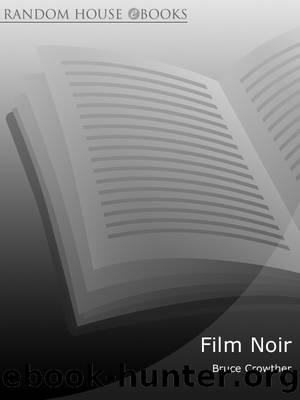Film Noir by Bruce Crowther

Author:Bruce Crowther [Crowther, Bruce]
Language: eng
Format: epub
Tags: Performing Arts, Film, History & Criticism
ISBN: 9780753546079
Google: TahCDf096XsC
Publisher: Random House
Published: 2011-12-31T20:38:24+00:00
âI donât wish to die of loving you.â
Force of Evil
TO A SIGNIFICANT extent, film noir is a manâs world. Most protagonists are men: the voice-over narration used in many films noirs is usually a manâs (among the few isolated exceptions is Jean Gillie as Margot Shelby in Decoy). The literary origins, the tough-guy writers and their hard-boiled heroes excluded women from principal roles. The dominance of men on the production side of the motion-picture industry â studio bosses, producers, directors, cinematographers, art directors, editors, screenwriters â militated against women. There were exceptions, of course: Ida Lupino as director and writer, Leigh Brackett as writer, but so few that the exceptions proved the rule.
The enforced subordination of women in film noir was exacerbated by an unmistakable measure of misogyny, especially noticeable in the novels of Cornell Woolrich and, much less overtly, in those of Raymond Chandler.
As a result of Hollywoodâs limited vision, women in film noir have tended to fall into two broad categories: one, a tiresomely predictable stereotype; the other, a powerfully impressive group which, against the odds, made a huge and dramatic impression upon audiences and engineered a major change in the perception of women in popular cinema.
The stereotype was the home-loving girl-next-door who retained a dog-like devotion to the hero despite his often perverse alienation.
The new women were startlingly different to the compliant, apple-pie-baking types. They, too, were supposed to be stereotypes, something like the vamps of an earlier era in motion picture-making, but the actresses who played them were well aware that bad-girl parts are infinitely superior to Goody-Two-Shoes roles and they revelled in the opportunities offered by some splendidly rich and varied roles.
Of course, there had been some powerful portrayers of dominant women, not least Bette Davis, Joan Crawford and Barbara Stanwyck, but such types were relatively rare. The advent of film noir, however, brought to the fore a new breed of woman. She was calculating, manipulative, cruel and she used her sexual attractions blatantly and without regard for the polite conventions of the past. She knew what she wanted and she didnât care what she did to get it. She understood that while society had dealt her a low hand from a stacked deck, she did have an ace up her sleeve: her body.
Although not usually intended to glorify actresses, these roles were used by some women to enhance fading reputations, and to carve new and highly successful careers. Some of the actresses who took the roles of noirâs spiderwomen had previously played home-lovers, which lent an intriguing sense of dislocation to their portrayals: Dorothy Malone, Gail Russell and Joan Bennett. Some had employed a coarse brassiness in previous roles as âthe other womanâ: Jan Sterling, Claire Trevor, Audrey Totter and Marie Windsor. There were a few who seemed to materialize out of nowhere, as if they were created especially for film noir (and one or two of this group vanished just as quickly afterwards): Gloria Grahame, Veronica Lake, Lizabeth Scott and Jane Greer. There
Download
This site does not store any files on its server. We only index and link to content provided by other sites. Please contact the content providers to delete copyright contents if any and email us, we'll remove relevant links or contents immediately.
The Kite Runner by Khaled Hosseini(5088)
Gerald's Game by Stephen King(4584)
Dialogue by Robert McKee(4328)
The Perils of Being Moderately Famous by Soha Ali Khan(4171)
The 101 Dalmatians by Dodie Smith(3455)
Story: Substance, Structure, Style and the Principles of Screenwriting by Robert McKee(3399)
The Pixar Touch by David A. Price(3369)
Confessions of a Video Vixen by Karrine Steffans(3247)
How Music Works by David Byrne(3191)
Fantastic Beasts: The Crimes of Grindelwald by J. K. Rowling(2997)
Harry Potter 4 - Harry Potter and The Goblet of Fire by J.K.Rowling(2996)
Slugfest by Reed Tucker(2946)
The Mental Game of Writing: How to Overcome Obstacles, Stay Creative and Productive, and Free Your Mind for Success by James Scott Bell(2848)
4 - Harry Potter and the Goblet of Fire by J.K. Rowling(2657)
Screenplay: The Foundations of Screenwriting by Syd Field(2576)
The Complete H. P. Lovecraft Reader by H.P. Lovecraft(2514)
Scandals of Classic Hollywood: Sex, Deviance, and Drama from the Golden Age of American Cinema by Anne Helen Petersen(2467)
Wildflower by Drew Barrymore(2447)
Robin by Dave Itzkoff(2387)
